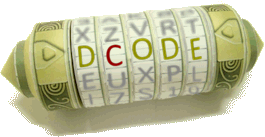Tool for decoding / encoding in Base32 according to RFC 4648. Base 32 is a variant of Base64 which uses letters and numbers from 2 to 7 (and =) as basic symbols.
Base32 - dCode
Tag(s) : Character Encoding
dCode is free and its tools are a valuable help in games, maths, geocaching, puzzles and problems to solve every day!
A suggestion ? a feedback ? a bug ? an idea ? Write to dCode!
Base32
Base32 Decoder
Base32 Encoder
Answers to Questions (FAQ)
What is Base32? (Definition)
Base32 is an encoding method standardized by RFC 4648. It allows binary data to be represented as text using 32 ASCII characters that are safe for transmission or storage. The standard alphabet is: ABCDEFGHIJKLMNOPQRSTUVWXYZ234567. The = character is used as a padding symbol to ensure a length that is a multiple of 8 characters.
How to encrypt using Base32 cipher?
Convert the original message into a binary sequence according to its encoding (such as ASCII or Unicode UTF-8).
Example: Base is encoded in ASCII (8-bits) 01000010,01100001,01110011,01100101
Group the bits into blocks of 5. Add trailing zeros (on the right) if necessary to complete the last block.
Example: The splitting gives the 32 bits 01000,01001,10000,10111,00110,11001,01000 (adding three trailing zeros).
Associate each 5-bit block with a Base32 character according to the lookup table:
| Binary | Decimal | Base32 |
|---|---|---|
| 00000 | 0 | A |
| 00001 | 1 | B |
| 00010 | 2 | C |
| 00011 | 3 | D |
| 00100 | 4 | E |
| 00101 | 5 | F |
| 00110 | 6 | G |
| 00111 | 7 | H |
| 01000 | 8 | I |
| 01001 | 9 | J |
| 01010 | 10 | K |
| 01011 | 11 | L |
| 01100 | 12 | M |
| 01101 | 13 | N |
| 01110 | 14 | O |
| 01111 | 15 | P |
| 10000 | 16 | Q |
| 10001 | 17 | R |
| 10010 | 18 | S |
| 10011 | 19 | T |
| 10100 | 20 | U |
| 10101 | 21 | V |
| 10110 | 22 | W |
| 10111 | 23 | X |
| 11000 | 24 | Y |
| 11001 | 25 | Z |
| 11010 | 26 | 2 |
| 11011 | 27 | 3 |
| 11100 | 28 | 4 |
| 11101 | 29 | 5 |
| 11110 | 30 | 6 |
| 11111 | 31 | 7 |
Example: 01000 for I, 01001 for J, and so on. Until IJQXGZI
Add the = character to the end of the string if the result is not a multiple of 8 characters.
Example: The Base message translates to the base32 IJQXGZI=
How to decrypt Base32 cipher?
The Base32 decoding is similar to a mathematical base change.
Example: Decode the message INXWIZI= coded in Base 32
Delete the final = of the encoded message.
Example: INXWIZI= becomes INXWIZI
Replace each character with its 5-bit value (cf conversion table) to create a binary string.
Example: I for 01000, N for 01101, etc. Until 01000,01101,10111,10110,01000,11001,01000
Read the binary string according to the encoding used (ASCII, Unicode, etc.)
How to recognize a Base32 ciphertext?
A B32-encoded message
— is composed only of the characters 'ABCDEFGHIJKLMNOPQRSTUVWXYZ234567 =' (no 0,1,8,9)
— theoretically has a number of character multiple of 8.
— ends with 0,1,3,4 or 6 characters = (equal).
— has a length greater than 40 to 60% of the original message
Why aren't digit 0 and 1 used in Base32?
The digit 0 is avoided not to be confused with the letter O, and the number 1 is also avoided for its resemblance to the letter I.
This makes Base32 strings safer to copy, read, or transmit manually.
What are the variants of the Base32 encoding?
Base32 is similar to Base64 which is much more commonly used.
The zbase32 code is a Base32 variant wanting to be more human-readable and writable.
The mathematical basis 32 (or base32hex) is the most natural version for writing numbers in base 32 and uses the symbols 0123456789abcdefghijklmnopqrstuv
Source code
dCode retains ownership of the "Base32" source code. Any algorithm for the "Base32" algorithm, applet or snippet or script (converter, solver, encryption / decryption, encoding / decoding, ciphering / deciphering, breaker, translator), or any "Base32" functions (calculate, convert, solve, decrypt / encrypt, decipher / cipher, decode / encode, translate) written in any informatic language (Python, Java, PHP, C#, Javascript, Matlab, etc.) or any database download or API access for "Base32" or any other element are not public (except explicit open source licence). Same with the download for offline use on PC, mobile, tablet, iPhone or Android app.
Reminder: dCode is an educational and teaching resource, accessible online for free and for everyone.
Cite dCode
The content of the page "Base32" and its results may be freely copied and reused, including for commercial purposes, provided that dCode.fr is cited as the source (Creative Commons CC-BY free distribution license).
Exporting the results is free and can be done simply by clicking on the export icons ⤓ (.csv or .txt format) or ⧉ (copy and paste).
To cite dCode.fr on another website, use the link:
In a scientific article or book, the recommended bibliographic citation is: Base32 on dCode.fr [online website], retrieved on 2025-11-29,
